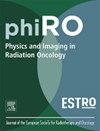一种在线自适应质子治疗的规划方法以应对锥束计算机断层扫描的不准确性
IF 3.3
Q2 ONCOLOGY
引用次数: 0
摘要
背景与目的在基于锥束计算机断层扫描(CBCT)的在线自适应质子治疗计划中,CT数误差可能会带来挑战。我们提出了一种在线自适应规划中通过增加距离鲁棒性设置(RRS)来处理CT数不确定性的方法。这与我们基于触发的离线(TB-Offline)自适应方法进行了比较,并与使用室内CT-on-rails (CTOR)的日常重新规划进行了比较。材料与方法对23例头颈癌患者进行CTOR和CBCT的单次检测。将CTOR轮廓严格复制到CBCT上。基于cbct的计划分别以3,6,8,10,12 %的RRS生成,每个计划的设置RRS为1 mm,然后在参考CTOR上进行前向剂量计算。这与我们的TB-Offline方法(3mm /3% SRS/RRS)的剂量分布进行了比较,也在CTOR上重新计算。比较两种策略的主要临床靶体积(CTV7000)和选择性淋巴结(CTV5425)的覆盖率(体素最小)和≥II级正常组织并发症的概率。结果从RRS = 3%提高到RRS = 10%, CTV5425 V94%从89.6%提高到96.4%,CTV7000 V94%从92.8%提高到96.4%。CTV7000和CTV5425分别在1/23和2/23的评估患者中观察到基于cbct的在线自适应和RRS = 10%的大量覆盖率损失(V94%< 95%)。与TB-Offline的3/23和4/23相比,这是一个改进。此外,当RRS = 10%时,与TB-Offline相比,口干的平均风险提高了2.4个百分点。结论:在基于cbct的在线自适应质子治疗中,增加范围鲁棒性设置的鲁棒优化有效地减轻了CT数误差引起的剂量退化。本文章由计算机程序翻译,如有差异,请以英文原文为准。
A planning approach for online adaptive proton therapy to cope with cone beam computed tomography inaccuracies
Background and purpose
In online-adaptive proton therapy planning based on cone beam computed tomography (CBCT), CT number errors can pose challenges. We propose an approach for coping with CT number uncertainties by increasing range robustness settings (RRS) in online-adaptive planning. This was compared to our trigger-based offline (TB-Offline) adaptive approach, and to daily replanning using in-room CT-on-rails (CTOR).
Material and methods
For 23 head-and-neck cancer patients, a CTOR and CBCT were acquired in a single fraction. CTOR contours were copied rigidly onto the CBCT. CBCT-based plans were generated with 3, 6, 8, 10, and 12 % RRS, each with 1 mm setup-RS, followed by a forward dose calculation on the reference CTOR. This was compared to dose distributions from our TB-Offline approach (3 mm/3% SRS/RRS), also recomputed on the CTOR. Coverage (voxelwise-minimum) of the primary clinical target volume (CTV7000) and elective lymph nodes (CTV5425) and grade ≥ II normal tissue complication probabilities were compared between strategies.
Results
When going from RRS = 3 % to RRS = 10 %, the population 90th percentiles of CTV5425 V94% improved from 89.6 % to 96.4 %, and CTV7000 V94% from 92.8 % to 96.4 %. Substantial coverage loss (V94%<95 %) with CBCT-based online adaptive and RRS = 10 % was observed in 1/23 evaluated patients for CTV7000 and 2/23 for CTV5425. This was an improvement compared to 3/23 and 4/23 with TB-Offline. Moreover, for RRS = 10 % the average risk of xerostomia improved by 2.4 percentage point compared to TB-Offline.
Conclusions
Robust optimization with increased range robustness settings effectively mitigated dose degradation from CT number errors in CBCT-based online-adaptive proton therapy.
求助全文
通过发布文献求助,成功后即可免费获取论文全文。
去求助
来源期刊

Physics and Imaging in Radiation Oncology
Physics and Astronomy-Radiation
CiteScore
5.30
自引率
18.90%
发文量
93
审稿时长
6 weeks
 求助内容:
求助内容: 应助结果提醒方式:
应助结果提醒方式:


